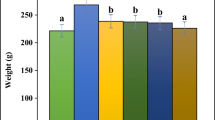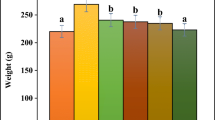Abstract
The fatty liver as a metabolic disorder has involved human beings globally and is usually followed by extreme obesity, increased blood lipid, and diabetes type II. Appropriate strategies for treating this disease are prioritized by each country. The aim of the recent research was to survey the remedial potential of aqueous extract of Allium saralicum R.M. Fritsch on the high-fat diet-induced fatty liver disease in Wistar male rats. In this study, 60 rats were used. A total of 10 rats were selected as the negative control, and the rest of them were treated with a high-fat diet for 4 months. Then, the animals were randomly divided into six subgroups, including negative healthy control, untreated negative control, and four groups receiving the aqueous extract of A. saralicum at 20, 40, 80, and 160 mg/kg concentrations. After 2 months, the rats were sacrificed and blood and liver samples of them were collected to analyze the biochemical and histopathological parameters. The data were analyzed by SPSS-21 software. All doses of A. saralicum (especially A160) could significantly (p ≤ 0.05) decrease the raised levels of ALP, AST, ALT, GGT, cholesterol, LDL, triglyceride, total and conjugated bilirubin, glucose, and GR and increased HDL, total protein, albumin, SOD, CAT, and GPx as compared to the untreated group. Also, aqueous extract of A. saralicum (especially A160) decreased the degree of hepatic steatosis as compared to the untreated group. In conclusion, the acquired results showed the hepatoprotective potential of aqueous extract of A. saralicum, so that it can use for the treatment of fatty liver disease.









Similar content being viewed by others
References
Askari F, Rashidkhani B, Hekmatdoost A (2014) Cinnamon may have therapeutic benefits on lipid profile, liver enzymes, insulin resistance, and high-sensitivity C-reactive protein in nonalcoholic fatty liver disease patients. Nutr Res 34(2):143–148
Augusti KT, Narayanan A, Pillai LS, Ebrahim RS, Sivadasan R, Sindhu KR, Subha I, Abdeen S, Nair SS (2001) Beneficial effects of garlic (Allium sativum Linn) on rats fed with diets containing cholesterol and either of the oil seeds, coconuts or groundnuts. Indian J Exp Biol 39(7):660–667
Comar KM, Sterling RK (2005) Review article: drug therapy for non-alcoholic fatty liver disease. Aliment Pharmacol Ther 23(2):207–215
Day CP (2006) From fat to inflammation. Gastroenterol 130:207–210
Day CP (2011) Non-alcoholic fatty liver disease: a massive problem. Clin Med 11(2):176–178
Ebrahimi-Mameghani M, Aliashrafi S, Javadzadeh Y, AsghariJafarabadi M (2014) The effect of Chlorella vulgaris supplementation on liver enzymes, serum glucose and lipid profile in patients with non-alcoholic fatty liver disease. Health Promot Perspect 4(1):107–115
Fan JG, Farrell GC (2009) Epidemiology of non-alcoholic fatty liver disease in China. J Hepatol 50(1):204–210
Farzaei MH, Zangeneh MM, Goodarzi N, Zangeneh A (2018) Stereological assessment of nephroprotective effects of Trachyspermum ammi essential oil against carbon tetrachloride-induced nephrotoxicity in mice. Int J Morphol 36(2):750–757
Ferramosca A, Di Giacomo M, Zara V (2017) Antioxidant dietary approach in treatment of fatty liver: new insights and updates. World J Gastroenterol 23(23):4146–4157
Flora K, Hahn M, Rosen H, Benner K (1998) Milk thistle (Silybum marianum) for the therapy of liver disease. Am J Gastroenterol 93(2):139–143
Ganz M, Csak T, Szabo G (2014) High fat diet feeding results in gender specific steatohepatitis and inflammasome activation. World J Gastroenterol 20:8525–8534
Ghashghaii A, Hashemnia M, Nikousefat Z, Zangeneh MM, Zangeneh A (2017) Wound healing potential of methanolic extract of Scrophularia striata in rats. Pharm Sci 23(4):256–263
Goodarzi N, Zangeneh MM, Zangeneh A, Najafi F, Tahvilian R (2017) Protective effects of ethanolic extract of Allium Saralicum R.M. Fritsch on CCl4-induced hepatotoxicity in mice. J Rafsanjan Univ Med Sci 16(3):227–238
Goodarzi N, Zangeneh MM, Zangeneh A (2018) The effect of ethanolic extract of Allium saralicum R.M. Fritsch on diabetic hepatopathy in male mice. Sci Res J Shahed Uni 25:21–30
Haga Y, Kanda T, Sasaki R, Nakamura M, Nakamoto S, Yokosuka O (2015) Nonalcoholic fatty liver disease and hepatic cirrhosis: comparison with viral hepatitis-associated steatosis. World J Gastroenterol 21:12989–12995
Hagh-Nazari L, Goodarzi N, Zangeneh MM, Zangeneh A, Tahvilian R, Moradi R (2017) Stereological study of kidney in streptozotocin-induced diabetic mice treated with ethanolic extract of Stevia rebaudiana (bitter fraction). Comp Clin Pathol 26(2):455–463
Hamelian M, Zangeneh MM, Amisama A, Varmira K, Veisi H (2018) Green synthesis of silver nanoparticles using Thymus kotschyanus extract and evaluation of their antioxidant, antibacterial and cytotoxic effects. Appl Organometal Chem 32. https://doi.org/10.1002/aoc.4458
Hashemi SJ, Hajiani E, Sardabi EH (2009) A placebo-controlled trial of silymarin in patients with nonalcoholic fatty liver disease. Hepat Mon 9(4):265–270
Hoseinpouran M, Khaki A, Nazem H (2015) Assessment of antioxidant properties of Allium cepa on serum antioxidants and spermatogenesis after consuming tartrazine in rat. Crescent J Med Biol Sci 2(4):125–129
Jacobs BP, Dennehy C, Ramirez G, Sapp J, Lawrence VA (2002) Milk thistle for the treatment of liver disease: a systematic review and meta-analysis. Am J Med 113(6):506–515
Kashkooli RI, Najafi SS, Sharif F, Hamedi A, Asl MKH, Kalyani MN, Birjandi M (2015) The effect of Berberis vulgaris extract on transaminase activities in non-alcoholic fatty liver disease. Hepat Mon 15(2):e25067
Lee N, Lee RM, Lee C (2017) Effects of dietary Allium hookeri root powder on the body fat deposition and biochemical parameters in guinea pigs. J Anim Res Nutr 2(2):1–6
Mohammadifar M, Behnam M, Talaei SA, Khamechian T, Mehran M, Taghizadeh M (2018) Evaluation effect of Silybum marianum, Cynara scolymus L. and Ziziphus jujube Mill. Combination extract on nonalcoholic fatty liver in rats. Iranian J Endocrinol Metab 19(6):410–418
Nikkhajoei M, Choopani R, Tansaz M, Heydarirad G, Hashem-Dabaghian F, Sahranavard S, Saberifiroozi M, Pasalar M (2016) Herbal medicines used in treatment of nonalcoholic fatty liver disease: a mini-review. Galen Med J 5(3):107–113
Ogunlade B, Saalu LC, Ogunmodede OS, Akunna GG, Adeeyo OA, Ajayi GO (2012) The salutary role of Allium cepa extract on the liver histology, liver oxidative status and liver marker enzymes of rabbits submitted to alcohol-induced toxicity. Am J Biochem Mol Biol 2(2):67–81
Panahi Y, Ghamarchehreh ME, Beiraghdar F, Zare R, Jalalian HR, Sahebkar A (2012) Investigation of the effects of Chlorella vulgaris supplementation in patients with non-alcoholic fatty liver disease: a randomized clinical trial. Hepatogastroenterol 59:2099–2103
Sakata R, Nakamura T, Torimura T, Ueno T, Sata M (2013) Green tea with high-density catechins improves liver function and fat infiltration in non-alcoholic fatty liver disease (NAFLD) patients: a double-blind placebo-controlled study. Int J Mol Med 32(5):989–994
Saravanan G, Ponmurugan P (2013) S-allylcysteine improves streptozotocin-induced alterations of blood glucose, liver cytochrome P450 2E1, plasma antioxidant system, and adipocytes hormones in diabetic rats. Int J Endocrinol Metab Disord 11(4):e10927
Sayyedrostami T, Pournaghi P, Ebrahimi Vosta-Kalaeea S, Zangeneh MM (2018) Evaluation of the wound healing activity of Chenopodium botrys leaves essential oil in rats (a short-term study). J Essent Oil Bear Pl 21(1):164–174
Shaker E, Mahmoud H, Mnaa S (2010) Silymarin, the antioxidant component and Silybum marianum extracts prevent liver damage. Food Chem Toxicol 48(3):803–806
Sharafzadeh S, Alizadeh O (2012) Some medicinal plants cultivated in Iran. J Appl Pharm Sci 2(1):134–137
Shavakhi A, Torki M, Khodadoostan M, Shavakhi S (2015) Effects of cumin on nonalcoholic steatohepatitis: a double blind, randomised, controlled trial. Adv Biomed Res. https://doi.org/10.4103/2277-9175.166149
Sherkatolabbasieh H, Hagh-Nazari L, Shafiezadeh S, Goodarzi N, Zangeneh MM, Zangeneh A (2017) Ameliorative effects of the ethanolic extract of Allium saralicum R.M. Fritsch on CCl4-induced nephrotoxicity in mice: a stereological examination. Arch Biol Sci 69(3):535–543
Tamayo C, Diamond S (2007) Review of clinical trials evaluating safety and efficacy of milk thistle (Silybum marianum [L.] Gaertn.). Integr Cancer Ther 6(2):146–157
Won JY, Yoo YC, Kang EJ, Yang H, Kim GH, Seon BJ, Kim SL, Han SH, Lee SS, Lee KS (2013) Chemical components, DPPH radical scavenging activity and inhibitory effects on nitric oxide production in Allium hookeri cultivated under open field and greenhouse conditions. J Korean Soc Food Sci Nutr 42(9):1351–1356
Wong VW, Wong GL, Chan AW, Chu WC, Choi PC, Chim AM, Yiu KK, Yu J, Chan FK, Chan HL (2013) Treatment of non-alcoholic steatohepatitis with Phyllanthus urinaria: a randomized trial. J Gastroenterol Hepatol 28(1):57–62
Zangeneh MM, Goodarzi N, Zangeneh A, Tahvilian R, Najafi F (2018) Amelioration of renal structural changes in STZ-induced diabetic mice with ethanolic extract of Allium saralicum R.M. Fritsch. Comp Clin Pathol 27(4):861–867
Zhaleh M, Sohrabi N, Zangeneh MM, Zangeneh A, Moradi R, Zhaleh H (2018) Chemical composition and antibacterial effects of essential oil of Rhus coriaria fruits in the west of Iran (Kermanshah). J Essent Oil Bear Plants 21(2):493–501
Author information
Authors and Affiliations
Corresponding author
Ethics declarations
Conflict of interest
The authors declare that there is no conflict of interest.
Ethic approval
All institutional and national guidelines for the care and use of laboratory animals were followed.
Rights and permissions
About this article
Cite this article
Moradi, R., Hajialiani, M., Salmani, S. et al. Effect of aqueous extract of Allium saralicum R.M. Fritsch on fatty liver induced by high-fat diet in Wistar rats. Comp Clin Pathol 28, 1205–1211 (2019). https://doi.org/10.1007/s00580-018-2834-y
Received:
Accepted:
Published:
Issue Date:
DOI: https://doi.org/10.1007/s00580-018-2834-y




